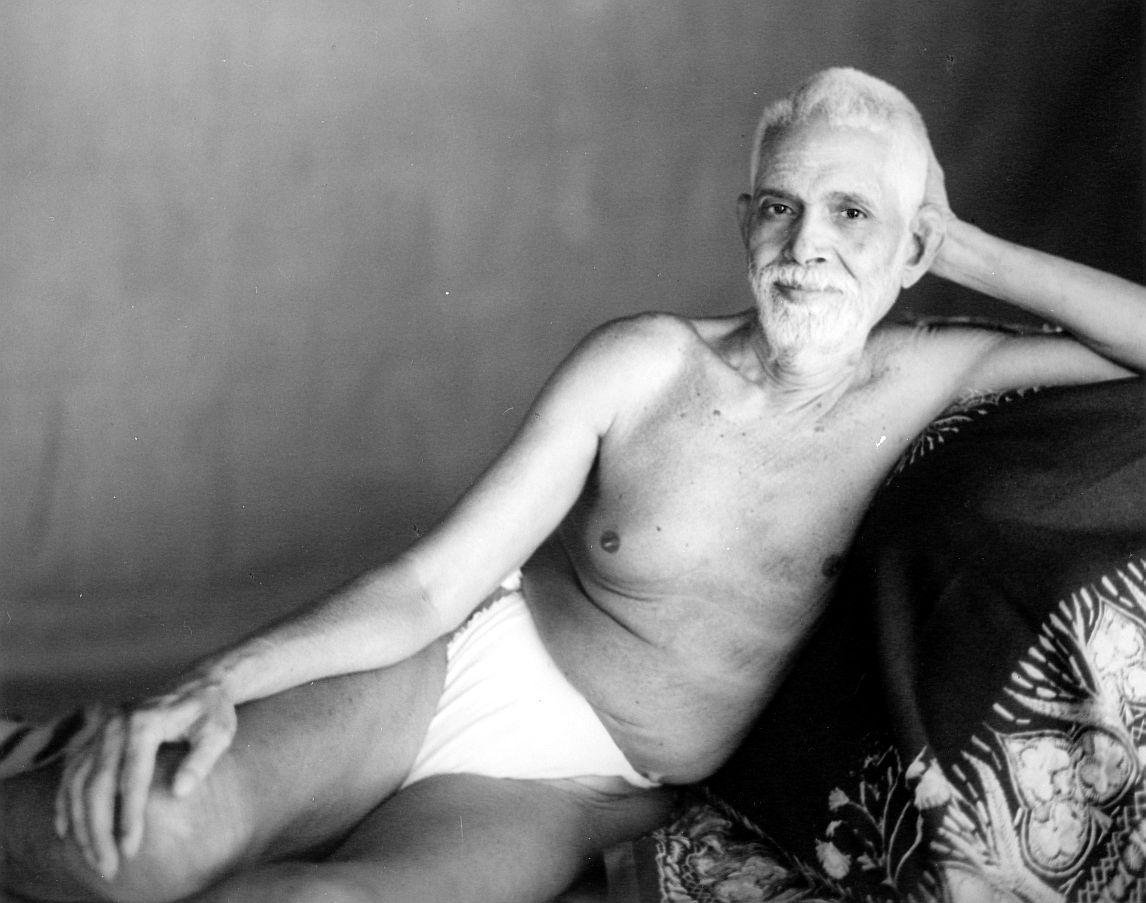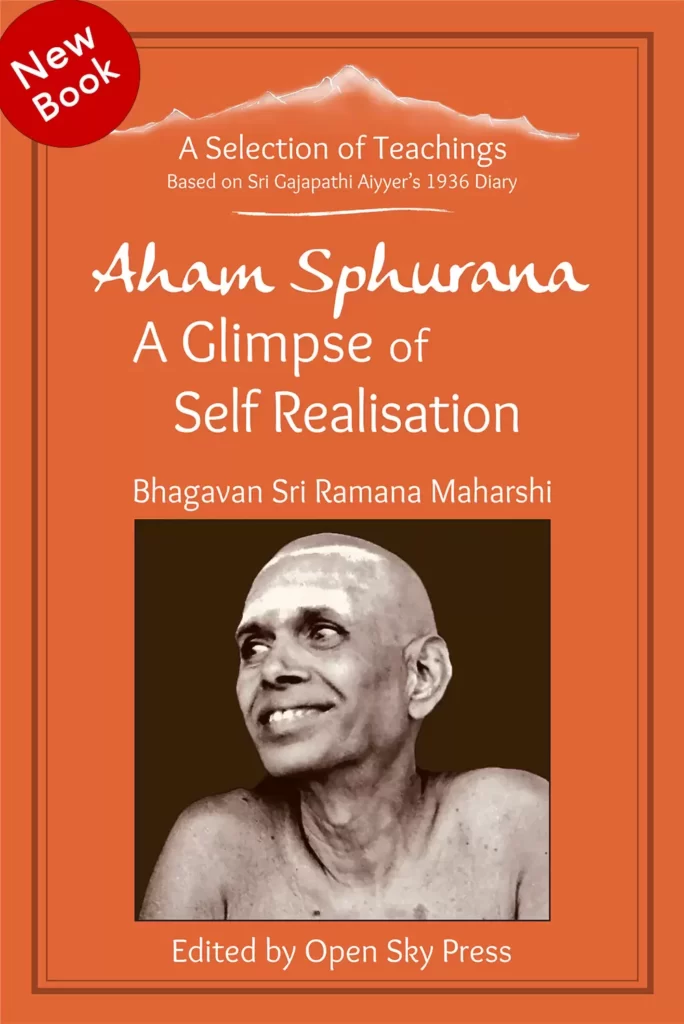
Aham Sphurana
A Glimpse of Self Realisation
New Book about Sri Ramana Maharshi

Available Worldwide
On www.openskypress.com and Amazon:

“In my opinion, Aham Sphurana, a Glimpse of Self Realisation, will become a Treasure Trove of Wisdom to the Seekers of Truth in general, and particularly to the devotees of Bhagavan.”
Swami Hamsananda – Athithi Ashram, Tiruvannamalai
Ramana Maharshi on Samadhi
Bhagavan called Chadwick to his side and said something to him. Chadwick exited the Hall and presently returned with a notebook, from which he read out as follows notes he had made from an early conversation with Bhagavan.
Chad.: I asked my master if He would mind giving me a detailed explanation concerning the term Samadhi, and its various kinds. The Lord Ramana graciously assented and sweetly spoke the following words:
B.: The meaning of the word Samadhi is generally given as Union with Reality, but it is not so. Samadhi means the State of non-differentiation from Reality or THAT-WHICH-IS. The following are its kinds:
- Savikalpa Samadhi. Mind is forced by effort of will to hold on to pure BEING, without such deliberate attentiveness or volition, the mind starts straying into the world of sense-objects or realm of thoughts again–vrittis or concepts remain in latent-form or seed-form–if concentration is sufficiently advanced one progresses from here to aham-sphurana. Aham-sphurana is generally not characterised by loss of body-consciousness–“I”-“I” pulsation is distinctly felt–bliss experienced–continuous inherence in aham-sphurana leads to sahaja samadhi thus bypassing requirement for kevala nirvikalpa samadhi.
- Kevala Nirvikalpa Samadhi. Mind temporarily merged in Parabrahman–like bucket dropped into well, but rope attached using which to haul it up again–rope represents vasanas or vrittis or samskaras–concepts or vrittis are merely in abeyance; they merely temporarily disappear only to reappear after the trance comes to an end–no possibility of “I”-“I” pulsation or any other sensation to be known during the duration of the trance–for that duration of time there is no one whom it can occur to–when the word “time” is used, it refers to the experience [not actual experience, for that is only Being, but apparent impression formed by an extroverted mind of the onlooker], of time passing.
A person immersed in kevala samadhi is not conscious of the passage of time because for that duration, as marked only by the observer, he is dead as an individual and alive only as Reality–no mind during kevala trance–thus, not possible to cognise anything known as “time”–complete absence of body-consciousness–even involuntary bodily functions cease–body becomes cadaver–no way to tell apart from actual cadaver–incumbent body may be abandoned for good due to the intensity of the bliss experienced–if so, taking up of new body, gross/ subtle, inevitable, because vrittis remain in seed-form–difference between yoga-nidra and kevala-samadhi–yoga nidra brought about based on Patanjali’s teachings or raja yoga method misapplied–deadliest of all stumbles on spiritual path–must be very careful to avoid–simply a long spell of sleep-like condition.
Story of man doing what he thought was tapas, on banks of river Ganges–asks disciple to fetch water from river to drink and goes into trance–wakes up 1000 years later–no river to be found–landscape has changed completely and finds his body immersed in a swamp–first thought that occurs to him after waking from trance–I want water to drink–therefore 1000 years totally wasted–yogi thinks experience of pleasure or bliss by him means salvation–nothing could be more absurd–many doing vichara think they have found Reality and fall into this trap.
Very difficult to leave–more addictive than cocaine, morphine, etc. how to find out if one is incumbently confronted with this danger–just after a heavy meal where favourite dishes have been served, one is relaxing–there is a pleasant lull in the mind–no thoughts–just pleasure which stands on the threshold of drowsiness–this is precisely similar to condition of yoga-nidra, only intensity of the pleasure is heightened manifold–mind not thinking, not sleeping, not dreaming, not cut-off to sensory perceptions totally, but yet NOT self-aware.
Just a blank mind–many piteous souls when asked to remain without thinking go to this state because this is the only thought-free state they know–think this is the goal of self-enquiry–think this is liberation–but this is a dead end–worst thing that could happen to a sadhaka–once mind gets used to this sort of poisonous pleasure, would find coming out less and less desirable and therefore progressively less and less feasible–no rescue possible after the initial stage–tamasic nature grows on increasing–eternal damnation–to avoid, mind must focus not on pleasure, or happiness, or joy but on ensuring absence of distractions to BE-ing–after certain critical limit of tamas reached and exceeded, rajas and satvas reduced to negligible quantities–thus taking on body to alter the balance between the gunas so that Realisation can be reached by making satvas only predominant guna, no longer possible because not adequate satvas and rajas left to work with to form body gross or subtle–no help possible–tamas grows and grows.
Body becomes a vegetable and then rots away–mind’s tamas is on the waxing–unless Iswara himself takes pity and adds rajas to favourably balance the mix, thus putting the poor soul in some primitive body, so that he can go on from there, increasing satvas, no deliverance possible–great danger in raja yoga and kundalini yoga method–that is why Bhagavan does not encourage–danger exists even for vichara practitioners who want pleasure or bliss more than freedom from bondage–whilst living on Hill Bhagavan encountered one such yogi adityanath–body falling into pieces on account of neglect–everyone thought he was in samadhi, revered him.
Bhagavan could see the truth. He had lost himself in a yogic trance [yoganiththirai]. Bhagavan tried to help him once. The man angrily pushed Bhagavan away, had become addicted to the pleasure, would never forsake it. Bhagavan left him to his fate and came away because nothing could be done. That is why it is important that AWARENESS OF BEING be sustained throughout the Sadhana. The moment self-awareness started to fluctuate or lull tried to take control, one had to stubbornly pull the mind back into realm of Being. Pleasure or bliss not the goal. Only one true goal is to destroy possibility of manifestation. Consciousness free from upadhis has got to be sustained throughout sadhana for it to succeed. Birth is man’s greatest disease. The Common man thinks birth = commencement-of-existence. Nothing could be further from the truth. Birth = assumption of limitations. This had to be understood at the intellectual level before any meaningful sadhana could begin.
- Sahaja Nirvikalpa Samadhi. No description in words could do it justice. No concepts, no sensations, no experience, no bliss, no cosmos, no person, no God, no nothing. HE IS THAT in which manifestation and its absence are contained and that by virtue of which presence or absence of manifestation is able to be perceived. Experience of the Self by the mind is blissful. Self itself neither bliss nor agony, it is as it is. The words trupthi or shanthi more meaningfully describe Self than ananda, though descriptions cannot afford a glimpse into that state. State known as Sahaja-stithi, not newly created–even now it is there and you are THAT, but mind veils it–search for mind–mind never existed, but it is to be practically discovered not to exist so as for Realisation to occur–discoverer himself does not remain to say I have made discovery–only Self remains–end of all effort–ONLY means of freedom from rebirth lies in this state.
Additional Notes: Kevala Samadhi state, though not as bad as nidra state, not in fact desirable–does not happen to all aspirants–’tis a waste of time that could otherwise be used to destroy vasanas that thwart one from reaching the final goal–goal not to attain Self–what nonsense, who can attain Self–besides the Self what could exist–are there two Selves–goal to destroy illusory not-Self so that Self alone remains.
Kevala samadhi generally achieved by faithful adherents of Patanjali or Ashtanga yoga school–again some danger–aspirant would think final goal has been reached once mind has known Brahman once–sheer absurdity–temptation to go into kevala samadhi instead of rooting out vasanas intense because of the terrific bliss felt–thus final goal delayed The right Master has to arrive to convince him this is not final state–problem is, would call himself a Brahmajnani, think himself to be a knower of Brahman, allow his ego to wax, would not listen to right advice–haughty behaviour may come on–thus this state best avoided
Family members may be alarmed, may cremate body, no telling when body-consciousness might return–vichara margam by-passes this stage–instead of this stage, aham sphurana already described serves as substitute–kevala samadhi in fact a by-lane, not to be aspired for–those who want Bliss of Brahman without losing personality or individuality, kevala samadhi last threshold for them.jnana-marga does not espouse desire for bliss–vichara
Margam aspirant must not aspire at all–remaining naturally without desire is the hallmark of ideal jnana marga aspirant–even desire for enlightenment is a serious hindrance–just like you eschew other desires, eschew desire for trance or bliss or enlightenment also, by asking, to whom same has occurred–REMAIN AS YOU ARE–free from thoughts, ideas, desires and all other sorts of vrittis–remaining in natural state alone true freedom, because this state cannot complain about embodiment or bondage–why sahaja samadhi explained only as negation–it is that which is beyond the ultimate.
Here no one besides the Self exists to experience the bliss of the Self, and the Self is not capable of experiencing anything, not even Itself–no question of pervading anything–nothing apart from Him for Him to pervade–that is why called advaita and not ekatva–no question of jivatman ever reaching Parabrahman–if He be pleased with aspirant’s sincerity, He himself reaches out and destroys him–this action naturally happens–no faculty of volition present in parabrahman to decide, let us give this jivatman liberation or destroy him–if jivatman approaches close enough, automatically sucked in and annihilated–but for this jivatman has to approach very very close.
Master gives example of asteroids passing close to the sun in orbit–the energy with [or velocity at or whatever it is] which the body is going around the sun and its distance from the sun would usually suffice to ensure that it was not pulled in by the massive gravity of the sun; progressive reduction in either of these two factors would make it more and more likely that the body might crash into the sun.
Likewise, according to Bhagavan. “I”-thought and its objectifying tendency were two factors that prevented ego from merging into Self–crush one of them totally, and that was enough–Guru’s Grace like friction-action of debris that gradually reduces the speed of the body and gradually alters the course of its orbit so that it will eventually surely gravitate toward Sun–devotional path snapped ego’s brain, the objectifying tendency–investigation path snapped ego’s heart, the “I”-thought–these two are aspects of same ego–killing one would kill the other and kill the ego–some aspirants ask I am ready for liberation why am I yet to be liberated–it shows they are not ready at all–the truly ready aspirant has no sankalpa or volition left to make any such communication, for the extent of his self-surrender is total.
What is surrender. To surrender is to cease to have any cares, leaving it to the Lord to do as he likes with you–the truly surrendered one asks nothing because he feels no need, no desire–he does not even want non-existence of misery, much less aspire for release from samsara–Jnani is always in samadhi whether body moves about or is stationary or is dead–Jnani cannot see his body–there is only one thing that He can do and know and that is to BE the Self–people say so-and-so is a Jnani–from the Jnani’s own point of view this has no meaning–nothing in him to manufacture the assertion I am a Jnani–there is simply no one there localised in terms of that body.
The wise sadhaka does not decide to quit the household–nor does he decide to move into the jungle–he silently surrenders his faculty of volition to the Higher Power and is meekly led by it wherever it takes him, jungle or household, heaven or hell–since he has already freed himself from the body-am-I idea, he would not think, “I am being taken somewhere.”–what is bakthi–unselfish love for God is called bakthi–unselfish love is not for the sake of acquisition of material possessions, nor for attainment of heavenly realms, nor for attainment of salvation, nor for breaking free from the wheel of births-and-deaths, nor for fulfilment of altruistic or philanthropic motives concerning upliftment of Humanity–unselfish love is not even accompanied by the hope or expectation of being loved in return; it has nothing to ask–unselfish love simply knows to love, that is all–the earnest baktha is not affected by the presence or absence of all or any of the worlds.
His own apparent existence is an inexplicable embarrassment for him, for to him everything is the Lord’s–his will becomes entirely non-existent, the Lord’s will taking its place–that is the love Job in the Bible had for God, that the gopis had for krishna, that karna had for duryodana, love that knows to love only–if you are able to cultivate this kind of mad, all-consuming love for God, the resultant intoxication will ensure that worries about employment, means-of-livelihood, etc., etc., are kept well away from your mind–the truly surrendered one has no hopes or expectations as to what he wants the future to be; whatever happens, he accepts the same as the will of his Lord; indeed, he sees only the Lord Himself in all the objects and events that he experiences in the jagrat and swapna states–you can never make him experience pain, because the moment his body feels distress, he tells himself, “It pleases the Lord to cause one of his possessions to undergo such-and-such sensations; who are we to question His will and why would we need to bother ourselves with the propriety of His decisions?
It is for us to meekly submit to Him, and, keeping quiet, leave the rest to Him; that is all.” cultivate this attitude and then no worry can touch you–you were not born by reason of your own volition; remain unconcerned, indifferent and disentangled also from everything that follows birth; this is the true renunciation–remaining as One with the Heart is neither a goal to be reached nor can it meaningfully be the object of any ambition or aspiration; it is the natural state of one and all; to remain as this pure undifferentiated Being, in which the faculty of otherness-causing differentiation is dead, and in which there are no concepts, is no accomplishment: it is THAT with which you are identical; it is you; YOU ARE THAT–what is liberation–complete bondage to God is known as liberation.
Major Chadwick from England is a long standing senior devotee of the Maharshi. He arrived a year before me and was fortunate enough to stay at the ashram right till the Master’s death. What you see above are the original notes made by Major Chadwick directly from the Sage’s words.
On this occasion, the gentleman was requested by Bhagavan only to read those portions of his notes that dealt with the topic of Samadhi. Accordingly he did so, reading out ad-lib sentences from the notes you find enclosed above. Since he spoke quickly, I had difficulty following him. Since I wanted the information, I later approached the gentleman and explained that I had failed to properly follow what he had read in the Hall, and that if I might read his notes I would be glad to do so. He accordingly consented and handed over to me a sheaf of papers, and I quickly copied out the notes contained in them.
I was so enchanted by Bhagavan’s words that I copied all of the notes the Major had made as contained in the said sheets, and not merely the portions pertaining to Samadhi. I have faithfully reproduced those very notes here, though they certainly extend beyond the scope of the conversations that took place at the Hall on this date, since I am confident the gentle reader will welcome any opportunity not to miss the Master’s words.
Whilst compiling this manuscript I wondered if I might convert these short hints into sentences; then I decided against it because I myself was not present when these statements were made by the Sage, and therefore, in the interest of preservation of authenticity, it struck me that it might be a better idea to leave them in their original, terse, pithy form.
I do not think any of the Master’s devotees would encounter any difficulty in ingesting, digesting, and assimilating these quick, incisive bites of wisdom.
Edited by John David Oct 2021
Aham Sphurana
A Glimpse of Self Realisation
New Book about Sri Ramana Maharshi

Available Worldwide
On www.openskypress.com and Amazon:

“In my opinion, Aham Sphurana, a Glimpse of Self Realisation, will become a Treasure Trove of Wisdom to the Seekers of Truth in general, and particularly to the devotees of Bhagavan.”
Swami Hamsananda – Athithi Ashram, Tiruvannamalai







